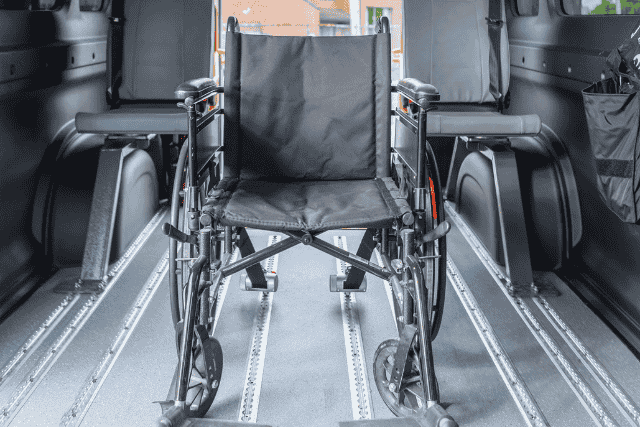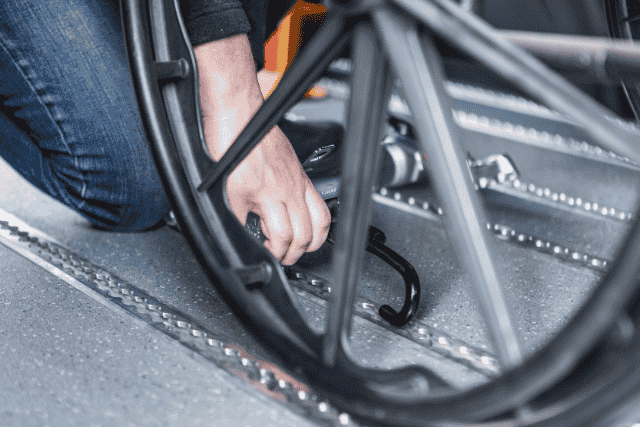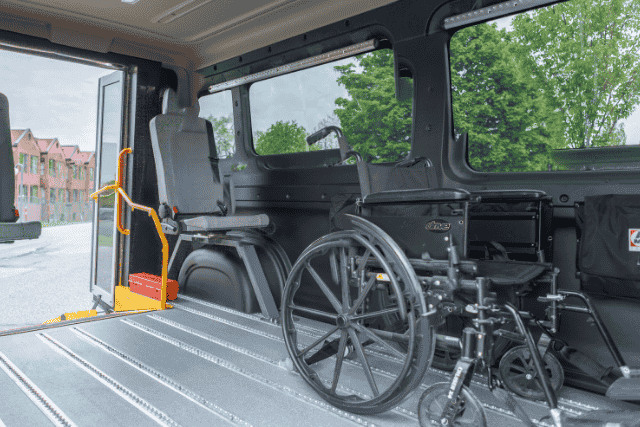Are you wondering how to secure a wheelchair in a van? It’s a common concern for many U.S. organizations that rely on wheelchair vans, from healthcare organizations to nursing homes. Not securing a wheelchair properly can put everyone at risk of injury, including the person in the wheelchair. If you’re considering a wheelchair van for your organization or if you already have one, understanding how to secure a wheelchair is very important.
At AVAN Mobility, we’ve been providing accessible, life-saving vehicles for over 10 years. Our mission is to make healthcare and transportation easier and safer for everyone. We’re committed to sharing our knowledge to help you make informed decisions. And while we’re proud of our expertise, we understand we’re not the only manufacturer in the field. Why not take a look at one of our past clients before we dive in?
In this article, we’ll walk you through 10 steps on how to secure a wheelchair in a van. Following these steps will teach you how to keep your passengers safe and comfortable, allowing you to focus on what matters most: serving your community.
*Use this guide as a general reference, and make sure to check with your mobility van provider for instructions tailored to your specific wheelchair restraint system. The steps below focus on using retractable restraints like the AMF Protektor system.
What Are Wheelchair Restraint Systems?
Accessible vans use special equipment, called wheelchair restraints, to keep wheelchairs safe during transport. These systems are essential to make sure the wheelchair doesn’t move while the van is on the road.
Here’s why wheelchair restraints matter:
Purpose: They stop the wheelchair from shifting or rolling while the van is moving.
Placement: The restraint system is secured directly into the van floor, holding the wheelchair firmly in place.
Safety: Without restraints, a wheelchair could roll around. This is dangerous if the driver has to make a sharp turn, brake suddenly, or, worst of all, is in a crash. Injuries are likely.
The most common wheelchair restraint system is called the four-point restraint. This system includes:
- Four straps: They attach to the wheelchair at four points.
- Lap and shoulder belts: These keep the person seated in their wheelchair securely.
Next up, we’ll explain how to use this four-point restraint system in nine steps to keep everyone safe on the road.
How to properly secure a wheelchair in a van using the four-point restraint system

Keep reading to learn about the nine steps involved in how to secure a wheelchair in a van.
Step 1: Use seats that meet FMVSS 207/210 standards
Make sure the seats and seatbelt anchor points in your wheelchair van meet FMVSS 207 and 210 regulations. These rules ensure that the seats are strong enough and the seatbelts are anchored securely to protect passengers in case of a crash. Always choose certified seating systems and verify proper installation for added peace of mind.
Step 2: Position the wheelchair correctly
Start by bringing the wheelchair into the van. Make sure the passenger is facing the front. If you’re using a side-entry van, you might need to turn the wheelchair so it faces forward. Place it in the right spot for safe transport.
Step 3: Lock the wheelchair in place

Next, apply the brakes on the wheelchair. If it has a power feature, turn it off. This helps keep the wheelchair from moving while you attach the restraints.
Step 4: Attach the first restraint to the wheelchair

Choose one of the four restraints. Attach it to the van floor at one corner of the wheelchair. There should be two at the front and two at the back for stability.
Step 5: Hook the restraint to the wheelchair frame
Pull the strap out and hook it onto the wheelchair frame. Make sure to avoid attaching it to removable parts, like armrests or leg rests. The strap should sit at a 45° angle to hold the wheelchair securely.

Step 6: Check for twists in the straps
Before moving on, look over the straps to check for any twists. Straighten out any twists you see. Overlapping or twisted straps can create safety risks during transport.
Step 7: Repeat steps 3 and 4 for each restraint
Now, repeat the attachment process for the other three restraints. Connect each one to a different corner of the wheelchair. This is a common practice in accessible vans across the U.S.
Step 8: Tighten the restraints to secure the wheelchair
Use the tightening knob on the retractors to make sure the wheelchair is snug. If your van has ratchet-style restraints, be cautious not to overtighten them, as this could cause damage.
Step 9: Secure the lap belt over the passenger’s lap
Place the lap belt over the passenger’s pelvic area. It should attach to the floor at a 45° angle to help keep them safely seated.
Step 10: Adjust the shoulder belt over the passenger
Lastly, place the shoulder belt over the passenger’s shoulder and hip. Ensure it doesn’t press too tightly against the neck. This belt should work like a regular seatbelt, extending from the passenger’s hip to the opposite shoulder.
With these steps, you can confidently secure a wheelchair for transport in many types of wheelchair-accessible vans in the U.S. Next, we’ll explore some important do’s and don’ts to enhance safety.
Things you should and shouldn’t do when securing a wheelchair in a van
| Things you should do | Things you shouldn’t do |
| Make sure the wheelchair passenger is facing the front. | Don’t twist, overlap, or cross the straps. |
| Make sure the lap and shoulder belts fit comfortably and aren’t too snug. | The passenger in the wheelchair should never be facing backward or sideways when you’re securing them. |
| Tighten the restraints so the wheelchair doesn’t move while driving. | Avoid using straps on parts of the wheelchair that can come off. This includes things like armrests or leg rests. |
Following these simple do’s can help keep your passengers safe when securing a wheelchair in a van. Staying away from these don’ts will help you avoid making mistakes that could be dangerous. Always check with your mobility van supplier for the best advice on securing wheelchairs properly.
Ready to keep wheelchairs safe in your van?
If your current wheelchair van securement system is giving you more headaches than solutions, it’s time to take a closer look. An unreliable system can lead to safety risks for your passengers, making every ride a stressful experience. Imagine worrying about whether your wheelchair will stay secure while you’re driving. That’s a gap you don’t want to have.
At AVAN Mobility, we know how vital it is to have a reliable securement system. That’s why we offer two wheelchair van options with dependable securement. Investing in a new van ensures your passengers’ safety. Interested? Check out the P4 wheelchair van in the video below.
With that in mind, you likely came here wanting to find the best ways to secure a wheelchair in a van. Now that you’ve read through the steps, you know how important it is to use a strong four-point restraint system to keep everyone safe.
We genuinely care about your peace of mind. We’re committed to making sure everyone has safe and reliable transportation. If you have any questions or need some advice, don’t hesitate to click the button below to chat with one of our friendly mobility experts.
And hey, if you’re not ready to reach out just yet, no worries! We’ve got plenty of other resources for you to explore that can help you learn more about keeping you and your passengers safe on the road.
Start by checking out our article on the 11 steps to choosing a wheelchair-accessible van. After that, you might be wondering, ‘How much does a wheelchair van cost?’ Watch the video below for the answer.





